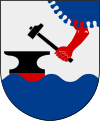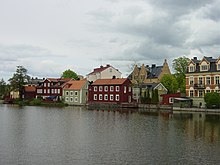Eskilstuna
| Eskilstuna | ||||
|
||||
| State : | Sweden | |||
| Province (län): | Södermanland County | |||
| Historical Province (landskap): | Södermanland | |||
| Municipality : | Eskilstuna | |||
| Coordinates : | 59 ° 22 ′ N , 16 ° 31 ′ E | |||
| SCB code : | 0740 | |||
| Status: | Crime scene | |||
| Residents : | 67,359 (December 31, 2015) | |||
| Area : | 29.8 km² | |||
| Population density : | 2260 inhabitants / km² | |||
| Height : | 26 m ö.h. | |||
| Postal code : | 630 03 - 638 21 | |||
| List of perpetrators in Södermanland County | ||||
Eskilstuna [ ˈɛskilstʉːna ] is the largest city in the Swedish province of Södermanland County , in the northwest of the historical province of Södermanland . Eskilstuna is the capital of the municipality of the same name .
geography
Eskilstuna is located on a small river between the lakes Hjälmaren and Mälaren . The name of the river is derived from the name of the city and is Eskilstunaån .
history
Tuna was an old trading post that used to be located here. St. Eskil , an English missionary , was buried at his bishopric Tuna around the year 1080. He gave the later city its name. The bishopric was moved to Strängnäs before 1120 . The Johanniterkloster von Tuna and the settlement belonged to the city of Torshälla . The Johanniter also went from Tuna to Strängnäs in 1170.
Karl Gustavs stad
Metal processing began at Eskilstuna in the 17th century . 1654 founded Reinhold Rademacher from Riga ( Swedish Livonia ) a metal manufaktur and forging at Eskilstunaån. On October 25, 1659, the up-and-coming settlement was given the name Karl Gustavs stad and city rights at this factory . King Karl X. Gustav granted her extensive privileges and a coat of arms. In the 1740s the new town was separated and combined with the old settlement of Tuna to form Eskilstuna.
Karl Gustavs stad has since developed west of the river and in 1771 was given the rights of a free city as Carl Gustafs stad . The privileges included exemption from Crown Tax, Customs and Accisen. Numerous businesses were characterized by small farmers, but each farm had a workshop in order to benefit from the tax advantages. Since then, the city has grown and is known for its small iron and armaments industries. The rifle factory Carl Gustafs stads gevärsffektori was bought by the state in 1812 and produced from 1813 to 1969 in new buildings on the Factory Hollow . In 1906 the museum forge Rademachersmedjorna was set up.
City of Eskilstuna
On September 17, 1660 Tuna was separated from Torshälla and the town charter was extended from Karl Gustavs stad to Tuna (today Gamla stad ). Since the growth of the new town, the town has been called Eskilstuna. On March 2, 1833 Eskilstuna was united with Carl Gustafs stad to form the city of Eskilstuna. In 1881 the city had 8,286 inhabitants. In 1907 Fors, Nyfors and Kloster were incorporated.
Eskilstuna municipality
In 1971 Eskilstuna was transformed into what is now Eskilstuna, a large community with over 100,000 inhabitants. Torshälla is formerly the oldest town in the municipality and is a titular town with limited self-administration and around 7600 inhabitants (Dec. 2010). A split in the community with Eskilstuna and Torshälla as the main towns was rejected in a referendum in 2006.
Attractions
The Rademachersmedjorna museum forge is particularly worth seeing . Here you can watch the blacksmiths and craftsmen at work that they still do in the traditional way. The old trading yard Tingsgården houses a glass and ceramic gallery . The city museum is located in the representative building that was built in 1813 for the rifle factory. The largest church in the city was completed in 1929 in the Kloster district. There is also the popular Parken Zoo theme park in Eskilstuna .
There is also the Re Tuna Återbruksgalleria in Eskilstuna . This is the first department store that only sells used, recycled or upcycled products.
economy
Eskilstuna is an industrial town particularly known for the production of tools and weapons . The Carl Gustafs stads gevärsffektori produced until 2012 and became internationally known for the production of submachine guns and bazookas .
Eskilstuna is also an important production site for the construction machinery manufacturer Volvo Construction Equipment, which is part of the Volvo AB group with its headquarters in Gothenburg.
Sports
Eskilstuna is the hometown of the AFC Eskilstuna football club , which competes in the Fotbollsallsvenskan , the highest Swedish division. The Eskilstuna Guif plays in the first handball league Handbollsligan . Eskilstuna also has a trotting track.
sons and daughters of the town
- Rickard Åkerman (* 1991), handball player
- Kennet Andersson (born 1967), football player
- Kristján Andrésson (* 1981), Icelandic handball player and coach
- Joakim Berg (* 1970), musician
- Emil Berggren (* 1986), handball player
- Mikail Bill (born 1991), esports player
- Börje Fredriksson (1937–1968), jazz musician
- Peter Fröjdfeldt (* 1963), football referee
- Daniel Gildenlöw (* 1973), musician
- Madeleine Gustafsson (* 1980), handball player
- Mats Hallin (* 1958), ice hockey player
- Kjell Johansson (1946–2011), table tennis player
- Martin Küchen (* 1966), jazz and improvisation musician
- Sebastian Larsson (* 1985), football player
- Anni-Frid Lyngstad (* 1945), singer
- Axel Persson (1888–1955), racing cyclist
- Stefan Therstam (* 1958), organist
- Mika Väyrynen (* 1981), Finnish football player
- Gustaf Wejnarth (1902–1990), athlete
- Tomas Svensson (* 1968), handball player
Twin cities
literature
- Eskilstuna, en vapensmedja: Carl Gustaf stads gevärsffektori 1813-2000. Eskilstuna 2008. ISBN 978-91-633-3496-2
Web links
Individual evidence
- ↑ a b Statistiska centralbyrån : Land area per Tatort, folkmängd and invånare per square kilometer. Vart femte år 1960 - 2015 (database query)
- ↑ Eskilstuna . In: Vetenskapsakademi (ed.): Sveriges statskalender för år 1925 . Almqvist & Wiksell boktryckeri AB, 1925, ZDB -ID 205099-7 , p. 1081 (Swedish, runeberg.org ).
- ↑ English - Retuna. Retrieved March 18, 2020 (sv-SE).





